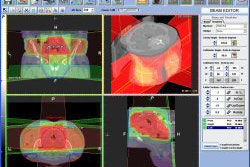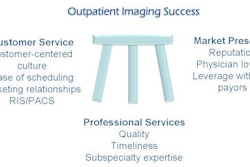Repetitive stress symptoms are highly prevalent among radiologists working in a PACS-based environment, and radiology departments should implement ergonomic initiatives to reduce the risk of injuries, according to research from Beth Israel Deaconess Medical Center in Boston.
"Our survey shows that repetitive stress symptoms are common among faculty members and trainees practicing in a digital radiology environment," wrote a research team led by Dr. Phillip Boiselle.
To determine the prevalence of repetitive stress symptoms among radiologists using PACS and to assess their responses to ergonomic interventions, the Beth Israel research team surveyed 107 faculty members, fellows, and residents working in a PACS-based radiology department (Journal of the American College of Radiology, August 2008, Vol. 5:8, pp. 919-923).
The survey included questions on the number of hours per day spent working at a personal computer or PACS monitor, the presence of repetitive stress symptoms, and prior diagnosis of repetitive stress syndrome. The researchers also asked respondents who had received ergonomic chairs, ergonomic workstations, or voluntary ergonomic training about the impact of those interventions using a seven-point Likert scale ranging from -3 (markedly worse) to +3 (markedly better).
The study team received 73 responses (68%) from 33 faculty members and 40 residents or fellows. From the 73 responses, 68% (including 55% of faculty members and 80% of trainees) said they worked more than eight hours a day at a computer or PACS monitor. A majority (55%) indicated they spent more than two hours per day in awkward positions.
Fifty-eight percent of the respondents reported repetitive stress symptoms, including 52% of faculty members and 63% of trainees (residents and fellows). Prior confirmed or suspected diagnoses of repetitive stress syndrome were reported by 38% of the respondents, including 39% of faculty members and 38% of trainees.
In good news, the study team noted improvements in repetitive stress symptoms (Likert scale ratings of 1 to 3) in 70% of the 54 respondents who had received ergonomic chairs. In addition, improvement was reported in 80% of the 55 respondents who had received ergonomic workstations and in 80% of the 20 respondents who had received ergonomic training.
A majority of respondents (56% to 71%) reported mild-to-moderate improvements (scale ratings of 1 to 2) in response to the ergonomic interventions, while a minority of respondents (10% to 13%) reported marked improvements (scale rating of 3) in symptoms, according to the study team.
While the survey revealed the prevalence of repetitive stress symptoms among faculty members and trainees in a digital radiology environment, it also showed that these symptoms are responsive to practical ergonomic interventions, the authors concluded.
"On the basis of these results, we encourage other departments to pursue ergonomic initiatives to provide safe working environments for their radiologists," the authors wrote.
By Erik L. Ridley
AuntMinnie.com staff writer
September 8, 2008
Related Reading
Lean principles and ergonomics aid imaging management, April 30, 2008
Kneeling, standing on the job boost arthritis risk, January 8, 2008
Repetitive stress injuries in radiology? You bet, November 28, 2007
Heavy keyboard use won't trigger carpal tunnel woe, November 28, 2007
Top 10 considerations for FFDM and PACS integration, October 4, 2007
Copyright © 2007 AuntMinnie.com




















